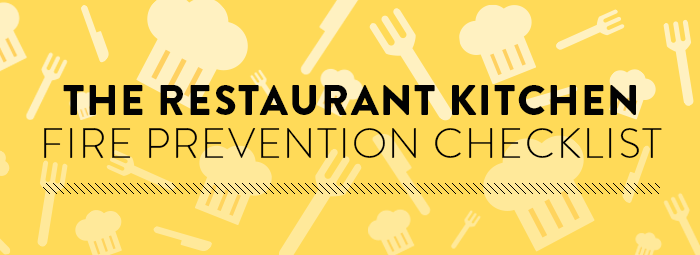
Keeping your kitchen safe from fires requires regular maintenance, inspection, and cleaning of kitchen appliances and surfaces. We have developed a helpful restaurant kitchen fire prevention checklist to help you reduce the risk of fire and be prepared in case one does occur.
Restaurant Kitchen Fire Prevention
Here is our guide for the perfect restaurant kitchen fire prevention checklist.

Inspect solid fuel cooking appliances on a monthly basis.
Cooking with solid fuel like wood and charcoal can significantly increase the risk of a kitchen fire because of the thick, flammable residue (creosote) these fuels deposit in the exhaust system. A monthly inspection and regular cleaning ensures the thick smoke and grease from wood or charcoal cooking does not build up to dangerous levels.
Have cooking appliances in low-volume kitchens inspected quarterly.
Low-volume kitchens are typically found in places like churches and community centers where cooking takes place occasionally. These facilities still require an annual inspection to ensure all appliances pose no risk for electrical or grease fires.
Have cooking appliances in moderate-volume kitchens inspected twice a year.
Moderate-volume kitchens, such as those found in many sit-down restaurants, should have appliances inspected twice a year. The inspection agency will likely recommend strategies for keeping your kitchen clean and safe in the time between checks based on what they see.
Have cooking appliances in high-volume kitchens inspected quarterly.
High-volume and 24-hour kitchens require quarterly inspections. Kitchens operating at a high volume should be especially careful about keeping all surfaces clear of flammable grease.
Equip cooking appliances with non-combustible grease filters.
The grease filters on all exhaust hoods should be non-combustible and easy to remove for cleaning. Since grease can easily catch fire, regularly cleaning greasy surfaces goes hand in hand with routine inspections. Equipment that can be easily taken apart and put back together for maintenance purposes can improve your fire safety routine.
Place only non-combustible, easily cleaned racks, trays, spacers, and containers inside ovens.
Like grease filters, all cooking equipment used inside an oven should be non-combustible and easy to clean. Keeping oven surfaces and equipment clean reduces the amount of flammable grease exposed to the oven’s heat source. In most cases, hot water and soap are sufficient for cleaning these surfaces and chemical degreasing agents are available for more difficult grease deposits.
Vent cooking appliances to the exterior of the building.
All exhaust should vent to the exterior of your building. An inefficient ventilation system keeps greasy exhaust, which can accumulate and raise the risk of fire inside the building. Check with your local inspection requirements to see if your ventilation systems are in compliance with your area’s kitchen codes.
Empty all grease containers at least once a day.
Even in a moderate-volume kitchen, grease can accumulate quickly. Deep fryer oil should be changed at least once a day for fire safety purposes. Grease pans for stoves and other appliances should also be cleaned daily. Grease traps beneath sinks are an exception– they typically require monthly maintenance and may be emptied by a professional when due for a cleaning.
Install appliances at an adequate distance from other surfaces.
Kitchen appliances operated too closely to adjacent surfaces are at risk for overheating and causing a fire. Check your local kitchen inspection requirements for a better understanding of how far each kind of appliance should sit from walls, cabinets, and other appliances. You can also see if walls neighboring appliances like ovens and fryers need to be treated with specific fire-proofing materials.
Train all kitchen staff on the hazards of fuel-air combustion, explosive materials, and ignition sources as well as how to operate equipment properly.
All staff who comes in contact with or operates kitchen equipment should be trained to use each appliance properly. In addition to knowing the fire safety details of each appliance, staff should be taught about common fire risks, how regular cleaning and maintenance decreases these risks, and what to do in the event of a kitchen fire.
With regular maintenance, inspection, and cleaning, you can greatly reduce the risk of fire in your kitchen. As always, be sure to adhere to your local fire safety standards and follow this checklist to keep your kitchen safe.
If you follow this restaurant kitchen fire prevention checklist, you will definitely reduce your chances for a fire and be prepared if a fire does occur.
______________________
Strike First Corporation Of America manufactures high standard & quality Dry Chemical Fire Extinguishers, Class K Kitchen Fire Extinguishers, and Carbon Dioxide Fire Extinguishers for your business and office needs. We also produce an unbeatable quality of Fire Extinguisher Cabinets and other Fire Extinguisher Accessories. Be sure to contact us to find a dealer near you today.

2 comments on “The Restaurant Kitchen Fire Prevention Checklist”
I have been in the food business about three years now. I’m surprised at how many people neglect fire safety. I took special note of your check list. Checking for excess grease is a big one.